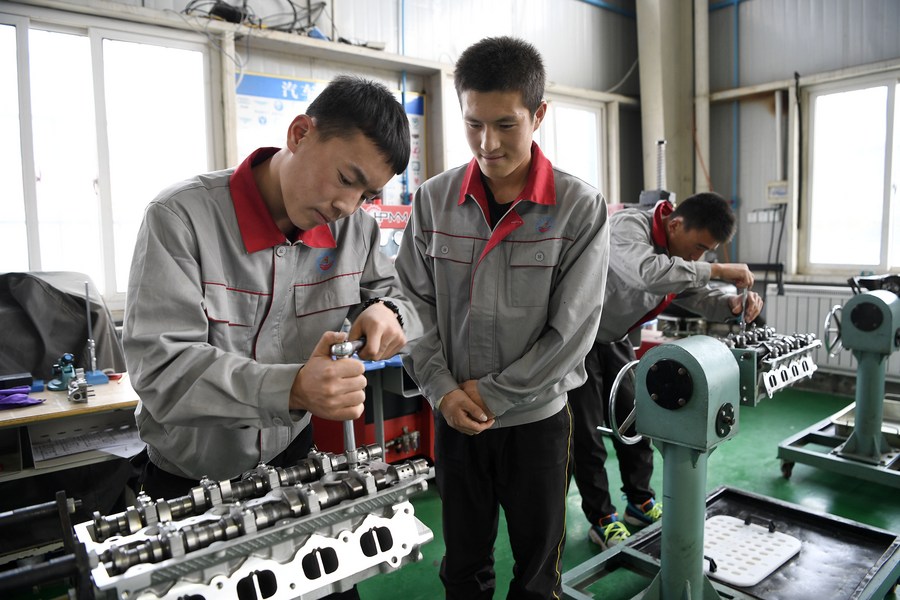China's vocational education props up high-quality development
China's vocational education serves as a vital source for talents in a broad array of sectors, such as modern manufacturing, while underpinning the upgrading of industrial structures and the urbanization and development of many cities.
Over the past 40 years, China has built the world's largest vocational education system, comprised of 11,300 vocational schools and 30.88 million students.

Students have a training class on auto repairing at a vocational school in Xiji County, northwest China's Ningxia Hui Autonomous Region, Sept. 16, 2020. (Xinhua/Wang Peng)
The past five years has witnessed a 21 percent increase in the number of vocational college specializations in key fields of manufacturing as well as a nearly 50 percent rise in the enrollment number. Moreover, a total of 2,100 majors focusing on elder care, nursery care and kindergarten education, and housekeeping have been established, with an overall annual recruitment number now exceeding 440,000.
Today, in diverse fields within modern manufacturing and in strategic emerging industries and modern service industries, more than 70 percent of the new frontline employees are being cultivated in vocational colleges.
According to Wang Fugui, president of a vocational high school in Taigu district, Jinzhong city, in north China's Shanxi province, all of the over 80 graduates majoring in numerically controlled welding were pre-selected and had posts reserved at designated enterprises, with the school having resumed classes in May last year as the COVID-19 epidemic was brought under control.
After establishing cooperative relations with several automobile enterprises, an automotive technical school in Changsha, central China's Hunan province was able to ensure that the employment rate for its new graduates could reach 100 percent, as disclosed by the school president Hu Dongsheng.
In a bid to improve the quality of personnel training and further sustain the upgrading of the country’s industrial structure, east China's Jiangxi province has strived to improve the practical training level of its vocational colleges and build China’s first vocational education virtual simulation (VR) demonstration training base with a total investment of 2.5 billion yuan ($381 million).
In the same vein, northwest China's Gansu province intends to focus on building 10 high-level vocational colleges and 30 high-level professional groups, as well as 35 high-quality secondary vocational schools and 100 specialties of premium quality.
South China's Hainan province has set up strategic cooperative relationships between more than 40 enterprises and a vocational tourism school in its capital city Haikou, jointly exploring the modern apprenticeship system. Students from this vocational school have served in roles at the annual meeting of the Boao Forum for Asia for 19 consecutive years with excellent comprehensive quality.
Many Chinese cities consider the integration between vocational education and industry to be a vital part of their strategy for urban development. For instance, Shanghai has issued a plan for the continued construction of the city that integrates industry and vocational education, promoting the signing of a number of major projects in application-oriented undergraduate institutes and higher-level vocational colleges.
Meanwhile, the high-tech zone of Wuxi city in east China's Jiangsu province has included the integrated development of the district and vocational education into its plan for the next five years, aiming to bridge the gap between specialized areas and industrial structures, as well as combining the training of talent with regional development.
Photos
Related Stories
- Higher vocational education contributes to China's employment, poverty alleviation
- Vocational education gives a leg up to China's poverty alleviation efforts
- Vocational education in China ensures more employment opportunities
- Vocational education helps with poverty alleviation in China: report
- Xi stresses importance of vocational education
- China helps more young people shake off poverty with free vocational education
- Premier highlights craftsmanship, innovation in vocational education
- China learns to love vocational education
- Top legislature conducts inquiry into vocational education after inspection
- Premier Li calls for developing vocational education
Copyright © 2021 People's Daily Online. All Rights Reserved.










